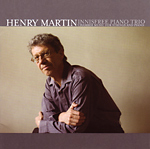Henry Martin’s Piano Trio opens with a slow introduction suffused with jazz-tinged harmonies that initially bring to mind the sophisticated coolness of Gil Evans. But said coolness evaporates with the start of the movement proper–a serious-minded allegro that proceeds in terse 7/8 meter (a favorite of Leonard Bernstein). After a touchingly somber slow movement, the finale lightens the mood considerably with its more pronounced jazz elements, particularly the quasi be-bop rhythms and melodic fragments.
Martin’s Sonata for cello solo begins in a mostly ruminative mood (one seemingly tailor-made for the instrument), but as the work progresses it offers many quite moving emotional outbursts. However, for non-cello aficionados the instrument’s unique timbre may begin to wear after a while. But, if you’d like to have the extended cadenza of Shostakovich’s First cello concerto extended a bit more, you’ll be quite pleased with Martin’s work.
In its first movement, This Living Hand (Sonata for violin and piano) has the instruments taking alternate solo turns rather than engaging in any real dialogue, while the second movement stages a stimulating conversation. Sweet Converse, which like the previous work is based on poetry by John Keats, draws ardent, tonally sumptuous music from the composer, although the astringent opening bars seemingly indicate otherwise.
The Innisfree Piano Trio’s performances are expertly executed and sincerely felt, while special mention is in order for Susan Seligman’s rapt playing in the Solo Cello Sonata. The recording unfortunately lacks warmth, having instead a somewhat hard and shallow sound. But it’s the music that matters, and Martin’s chamber compositions are well worth investigating.
































